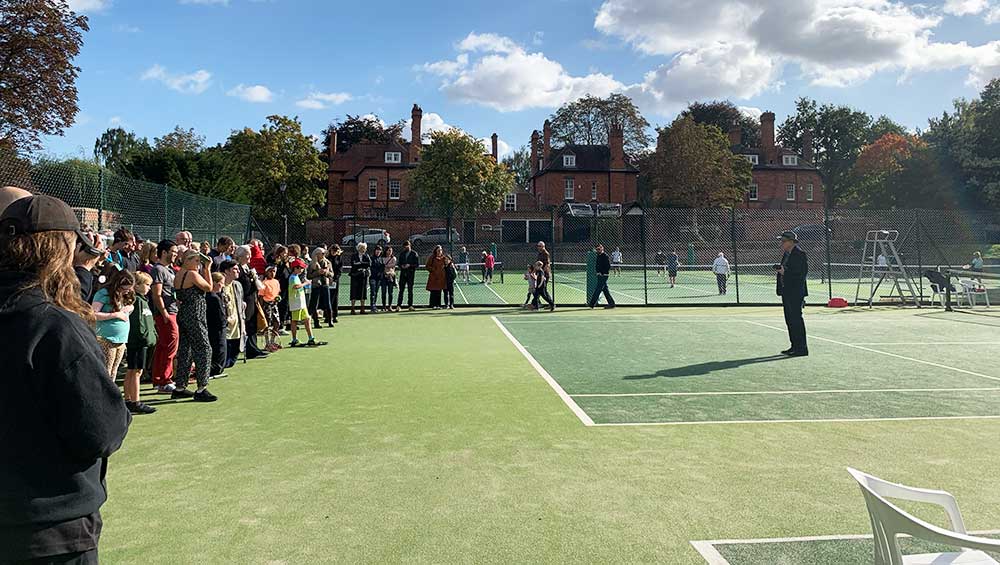
Stephen Willats at the launch of Social Resource Project for Tennis Clubs: Tennis Tournament, Saturday 8 October 2022, The Park Tennis Club, Nottingham. Photo: Bronac Ferran.
Bonington Gallery, Nottingham Trent University
10 October – 10 December 2022
by BRONAĊ FERRAN
Bright sunlight wreathes the Park Tennis Club, which lies in a conservation area of Nottingham, to where I am heading for the launch event of a contemporary revisiting by Bonington Gallery of one of Stephen Willats’ most iconic projects of the early 1970s. With an atmosphere like an amphitheatre in an Edwardian film, the Park Club sits at the heart of the Park residential estate, where streets are lit at night by gas lamps. Even by day, it feels like a bygone era. It was while living in this neighbourhood half a century ago, when employed part-time in the fine art department at Trent polytechnic (now Nottingham Trent University), that Willats conceived his Social Resource Project for Tennis Clubs (1972).
This afternoon, he is standing on one of the tennis courts, giving a brief and poignant entrée to this occasion, which is, like much of what he has done as an artist, an intervention that still seems to work directly against the grain of social convention. Indeed, a call-out to local residents to come to the launch of the exhibition, published in Park News on 8 October, stated: “Please join us for a restaging of Steve Willet’s [sic] 1970’s [sic] Tennis Tournament that happened at the conclusion of his original social art project … Stephen will be working with tennis club members to remodel the game of tennis based on their reasons for joining the club – using this site and experience as a simulation of a transformed society. It will be nothing if not bizzare [sic]– with coffee and cake to boot.”
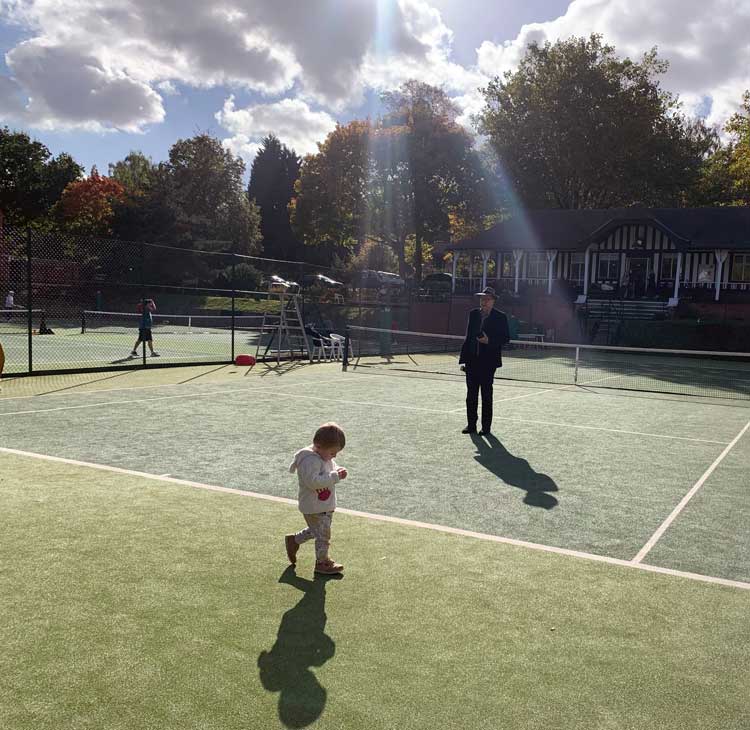
Stephen Willats. Social Resource Project for Tennis Clubs: Tennis Tournament, Saturday 8 October 2022. The Park Tennis Club, Nottingham. Photo: Bronac Ferran.
The event is happening on a day tailor-made for photography, with long shadows lingering over the leafy splendour of the setting and stretching in front of Willats as he addresses attendees, many young enough to be his grandchildren. He duly shares recollections of how, in the early 70s, he decided it was time for “the jettisoning of object-bound art that was enclosed within the exclusivity of art galleries”. In keeping with this, he and others at the art school began to explore interdisciplinary domains, proactively moving beyond the “language island” of the art school into an engagement with local communities within the city.1 This included knocking on doors of housing estates with questionnaires, inviting people to share their views on various subjects.
It was from this creative fermentation that Willats’ Social Resource Project for Tennis Clubs evolved, conceived to create links between four clubs in the city situated in varying socio-economic contexts. This project was germinal to an internal transformation taking place in Willats’ practice, away from what he has called his relatively “phenomenological” focus of the 60s. Instead, he sought to devise conceptual schema that might facilitate a way for groups and individuals to become more conscious of how their lives were determined by a set of behavioural and other codes, that might in turn be altered and transformed by various projections towards an alternative, perhaps more ideal, reality. Willats has spoken also of prototyping ideas and processes that he later used in other titles of the 70s within this project, making it a milestone in terms of a longer trajectory.
When curators at Nottingham City Museums approached Willats about the acquisition of primary source materials held in his personal collection related to the tennis clubs project, Willats responded positively. Such activities form an important part of a yet to be fully written cultural history of Nottingham as a significant laboratory of radical artistic experimentation over several decades, as the base of organisations such as The Midland Group, with which Willats worked in the early 70s on an exhibition of outputs from the tennis club project.
The curatorial team at Bonington Gallery also swiftly became involved, proposing an exhibition that would go beyond a dry showing of archival material to a more dynamic interrelation with the present. To facilitate a celebratory revisiting of one of the questions encoded by Willats into the original project – how might the rules of tennis be rewritten, in self-organising fashion? – a call went out to members of the Park Tennis Club (many of whom proved sceptical) for volunteer participants, and to various artistic networks linked to Nottingham Trent University. Four groups were duly formed: each devised its own set of rules or misrules, having been encouraged to do so by Willats, who saw setting the conceptual schema as his own key contribution.
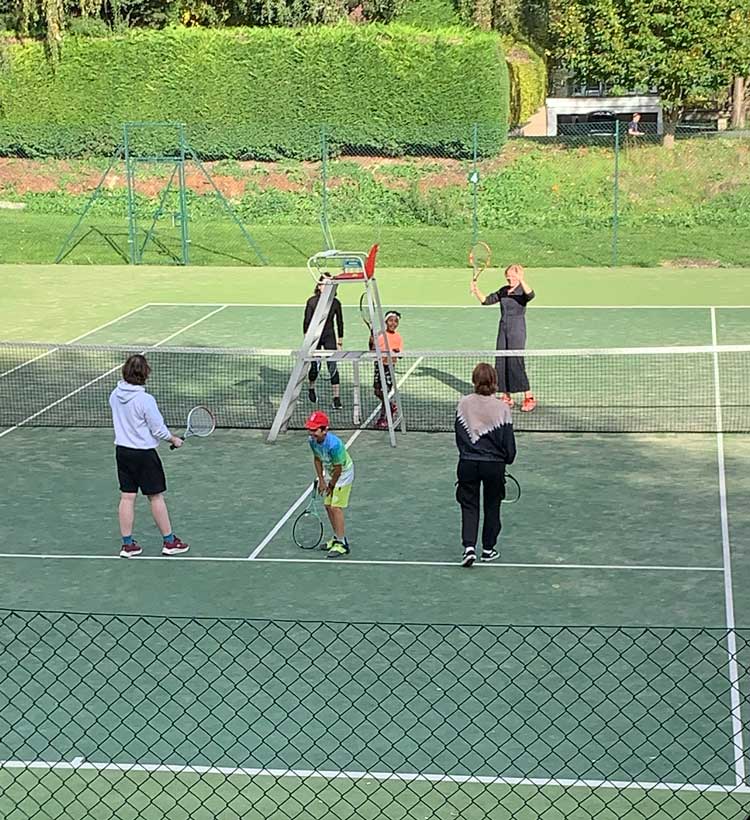
Stephen Willats. Social Resource Project for Tennis Clubs: Tennis Tournament, Saturday 8 October 2022. The Park Tennis Club, Nottingham. Photo: Bronac Ferran.
Older and newer representatives of what I overhear a regular Park Tennis Club member refer to as “Stephen Willats’ fan club”, gather on the grassy verges overlooking the courts to watch a series of, at times, hilarious improvisatory actions. The first group, which includes the Park Tennis Club’s membership secretary and two of its talented junior members, varies the number of players on each side of the net and plays with balls of odd shapes and sizes that bounce at highly erratic angles. More than one ball found its way into the air simultaneously, and the two youngest players swiftly recognised that the best tactic was to dominate the net area, avoiding the bounce while at the same time asserting their youthful capacity for leaping agilely around.
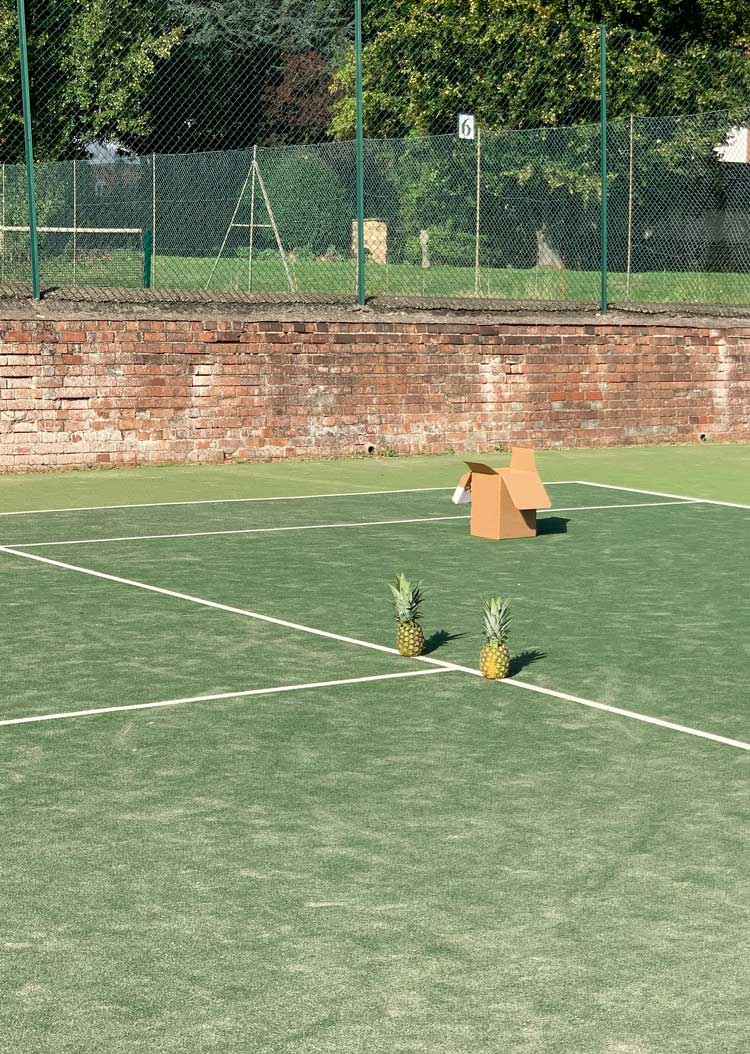
Stephen Willats. Social Resource Project for Tennis Clubs: Tennis Tournament, Saturday 8 October 2022. The Park Tennis Club, Nottingham. Photo: Bronac Ferran.
Another group, comprised primarily of artist-tutors at Nottingham Trent University, laid out on the court a series of incongruous items, including a blow-up crocodile and two plastic pineapples. A female umpire oversaw proceedings, with the other members following a set of “tentative rules” for what the group called “Austerity Obstacle Tennis”. These sought to shift what took place into cooperative, rather than competitive, directions.
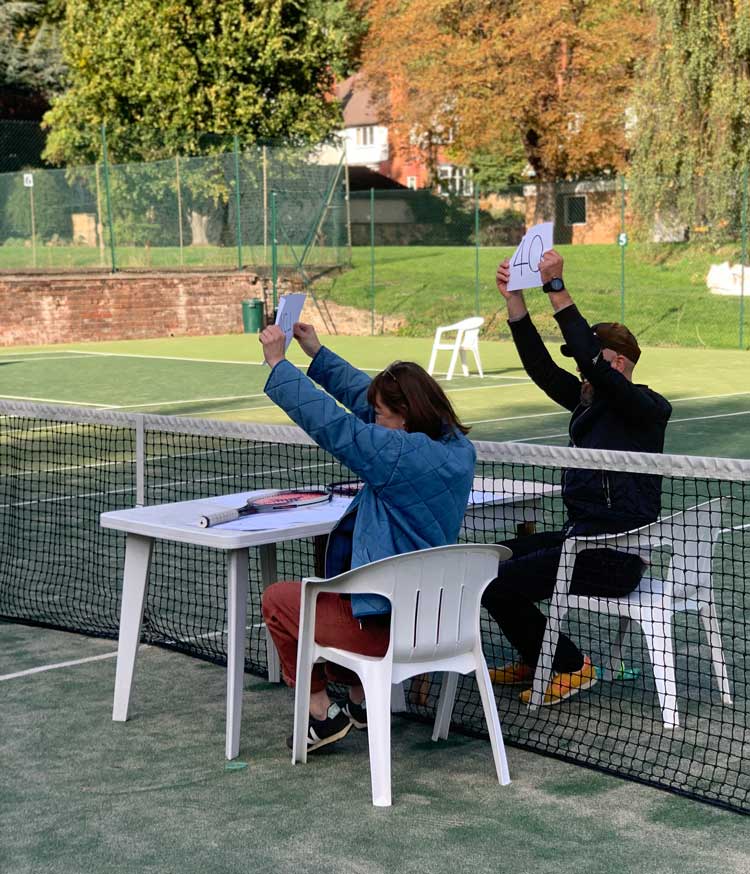
Stephen Willats. Social Resource Project for Tennis Clubs: Tennis Tournament, Saturday 8 October 2022. The Park Tennis Club, Nottingham. Photo: Bronac Ferran.
Yet another group moved the umpire’s chair into the centre of the court and sought to land the ball within it. My favourite among the four groups dispensed entirely with the act of hitting the ball over the net and within the white lines. Instead, a duo sat on white chairs at the centre of the court and, with finely tuned performative timing, took turns to hold up single sheets of paper on which had been written words such as “foot fault”. Inevitably, a chorus of feedback arose from those watching, who raised their own sheets of paper on which were written comments such as ‘’rubbish” and “waste of public money”.
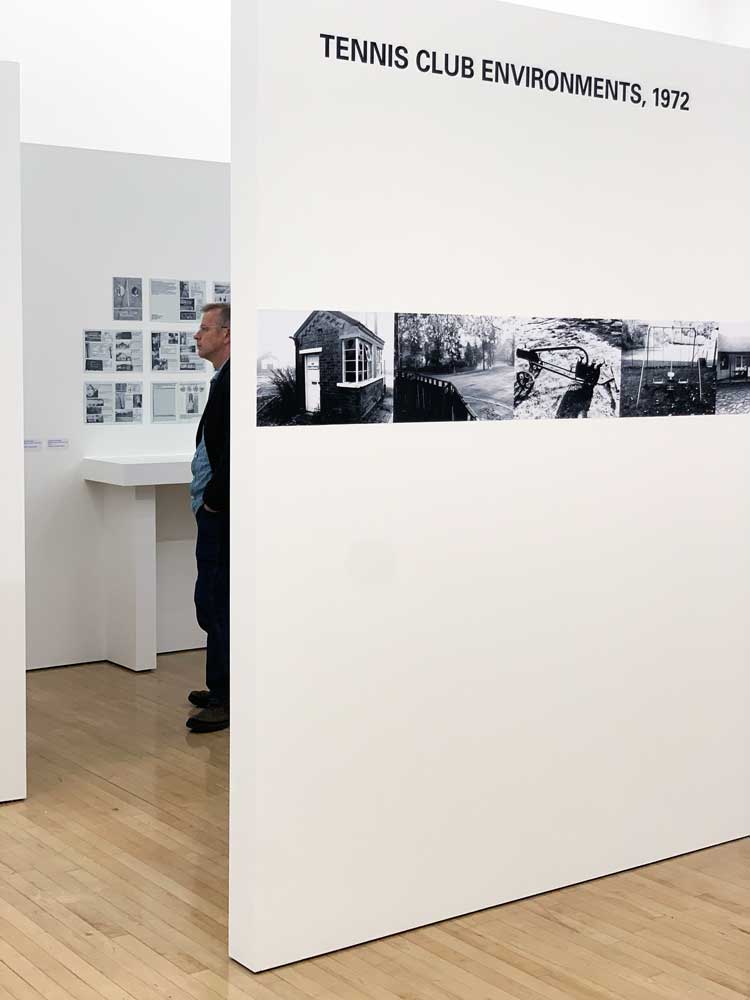
Stephen Willats. Social Resource Project for Tennis Clubs, installation view, Bonington Gallery. Photo: Bronac Ferran.
The afternoon’s events were followed by a preview opening at Bonington Gallery of an exhibition that offers the first focused curatorial contextualisation of Willats’ tennis club project. It makes visible rarely seen graphic and visual material, as well as correspondence, generated in the early 70s, and combines this with a contemporary revisiting by Willats (that also has key moments of photographic poignancy) of sites in which the original project was located. As well as presenting an invaluable documentary record of a period of intensive innovation at the meeting point between art and society, the fact that the context in which this material is now being shown has a fundamental relation to the content on display adds to its thought-provoking impact.
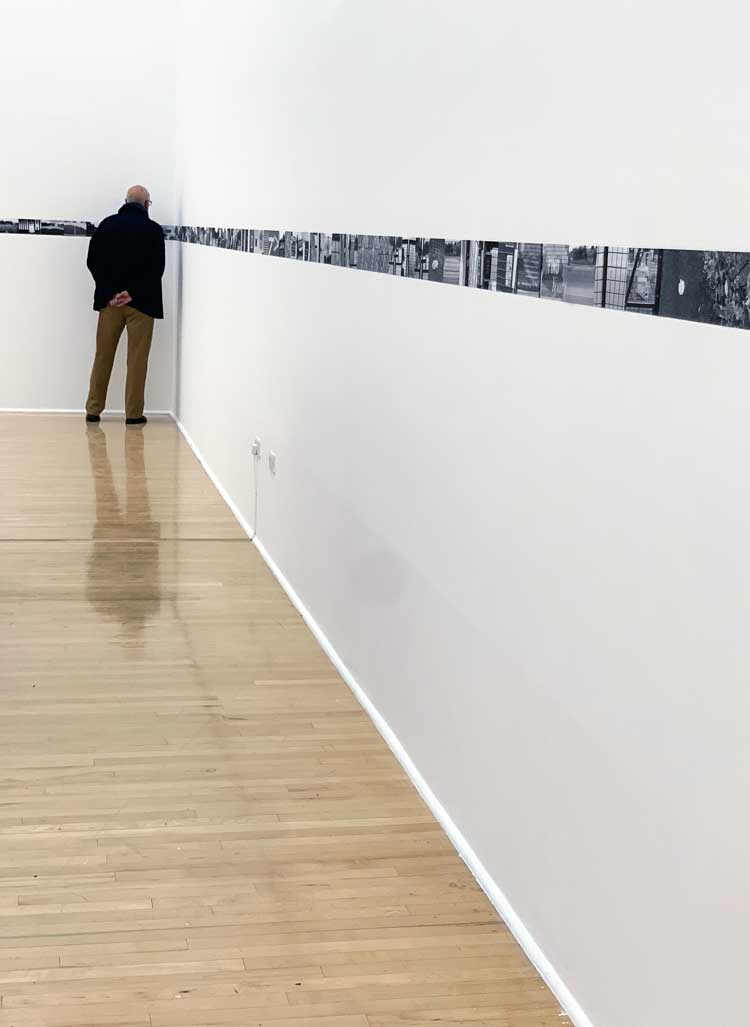
Stephen Willats. Social Resource Project for Tennis Clubs, installation view, Bonington Gallery. Photo: Bronac Ferran.
As I walked around the gallery, I got a new sense of Willats’ semiotic reading of the idealised, universalising, quasi-cybernetic game of tennis and how, over the 50-year gap between the initial project and the present, shifts in the socio-economic and environmental contexts in which this project initially developed, have served to amplify an underlying class division that was already implicit in its initial instantiation. Visitors need to look closely to find evidence of these dimensions, as the curatorial narrative (rightly, it seems to me) is one that unfolds on a perceptual level rather than though the overlaying of a prescriptive commentary.

Stephen Willats. Social Resource Project for Tennis Clubs, installation view, Bonington Gallery. Photo: Bronac Ferran.
A primary focal point in my own orientation around the exhibition is a new, label-free montage of images of “signs” photographed by Willats during site visits to the four original tennis club locations earlier this year. Its vertical centring on the walls has a clean effect that draws the viewer into closer focus to register sites where humans have been sidelined in favour of lines, signs, numbers, meshes, nets and other boundary zones. We see differences, moreover, between what has been photographed this year and an equivalent set of images taken by Willats half a century earlier. Willats also achieves this effect of contrast in showing the degree to which changes have occurred (or not) with respect to related clubhouse buildings as places that embody a social culture around the game of tennis.
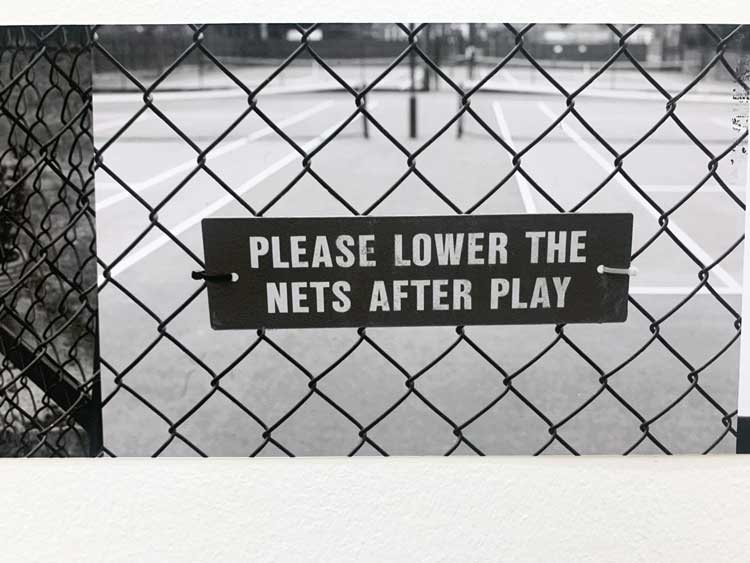
Stephen Willats. Social Resource Project for Tennis Clubs, installation view, Bonington Gallery. Photo: Bronac Ferran.
The exhibition enables us also to realise how Willats’ interest in “meshes” and cybernetic systems, already manifest in various semiotic ways in his titles of the 60s and the early 70s, found real-life application in the tennis club project. Writing in 1967, before he looked to tennis as a site of conceptual realisation of his ideas, Willats was writing of the “development of fantasy structures achieved through mind projection, their hardware being a ball of thought”. He referred also to the symbol of the “mesh” that he often used within his process iconography, to signify what he described as a “mosaic structured behavioural net, acting as homeostatic model for life structures. This ‘net structure’ [has] ‘one layer’ [with] all the notes within the mesh having connections with all other nodes as equal.”2 Indeed, there are numerous different images of meshes and nets in the exhibition.
Within the semi-enclosed construct in the gallery, a beautifully laid-out display draws the earlier material together into a form of documentary overview within which we see, for example, hitherto unpublished letters written by Willats to various lawn tennis club representatives to garner support for what he was doing. These reflect his sense of the innate value of working with this specific sport to realise his ideas, meaning that, rather than standing on the outside looking in, he was willing to engage in direct communication with those who might be viewed as established representatives of a sport.
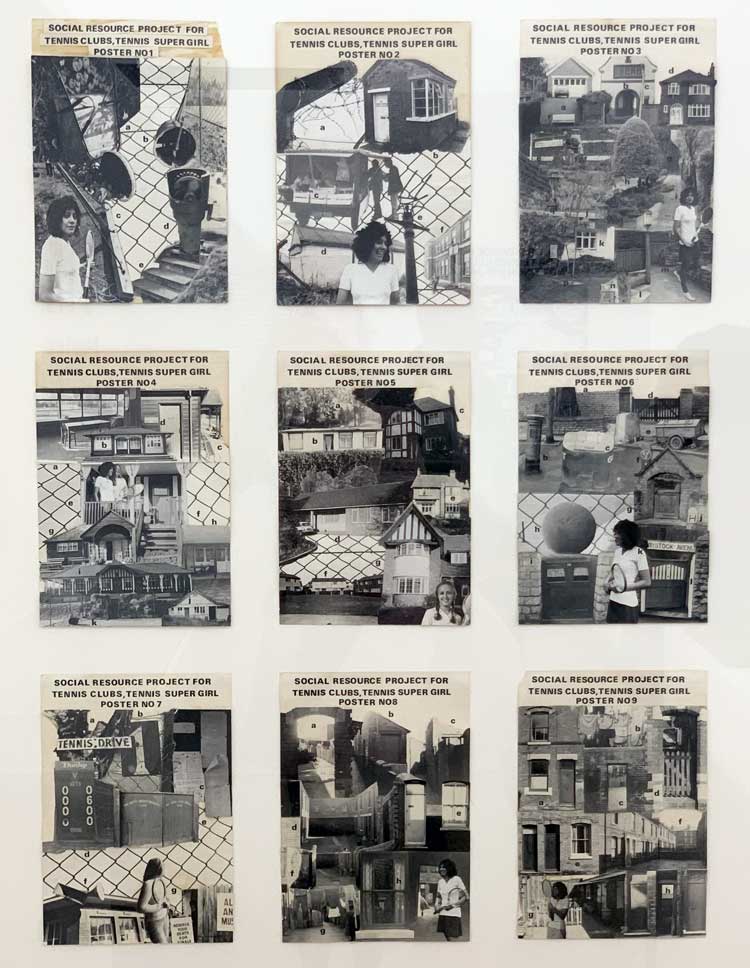
Stephen Willats. Tennis Super Girl posters 1-9, Social Resource Project for Tennis Clubs, 1971/2. Photographic prints, Letraset text on card. Photo: Bronac Ferran.
The material seen within this semi-enclosed space also includes a series of Super Girl posters, as well as other print outputs from the original project, including his I-Spy Book of Tennis and the related manual that documented ideas emerging among tennis club members in the early 70s for potential transformation of the rules of the game. Importantly, also, here at the centre of the gallery, we see various programmatic drawings and diagrams created by Willats, conveying the theoretical basis for the project and the process-based nature of its development.
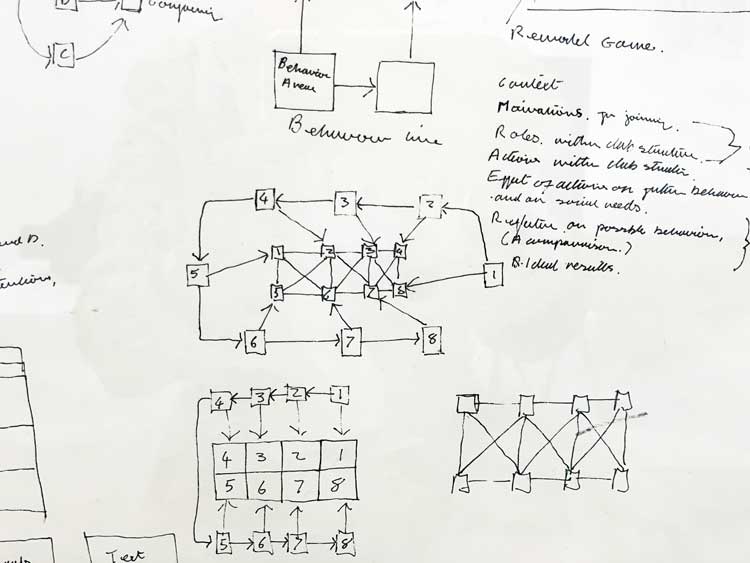
Stephen Willats. Theoretical Models, set of four diagrams (detail), Social Resource Project for Tennis Clubs, 1971/2. Mixed media on paper. Photo: Bronac Ferran.
There is also a further new work, Signs and Messages from Park Tennis Club Nottingham (2022), which shows a sequence of filmed images in rapid succession based on visual cues, data and signs that Willats captured during a visit this spring to the grounds of the Park Tennis Club. What we might note in this instance is a sense of care and preservation that characterises this specific environment, even with respect to small things, that might generally be overlooked, such as the renewal of the painting of court numbers on the ground. On the night of the opening, the club membership secretary was pointing at the film screen, surprised to see that little interventions that he had made in the general service of upkeep around the club had ended up being captured by the sensitivity of Willats’ photo-lens.
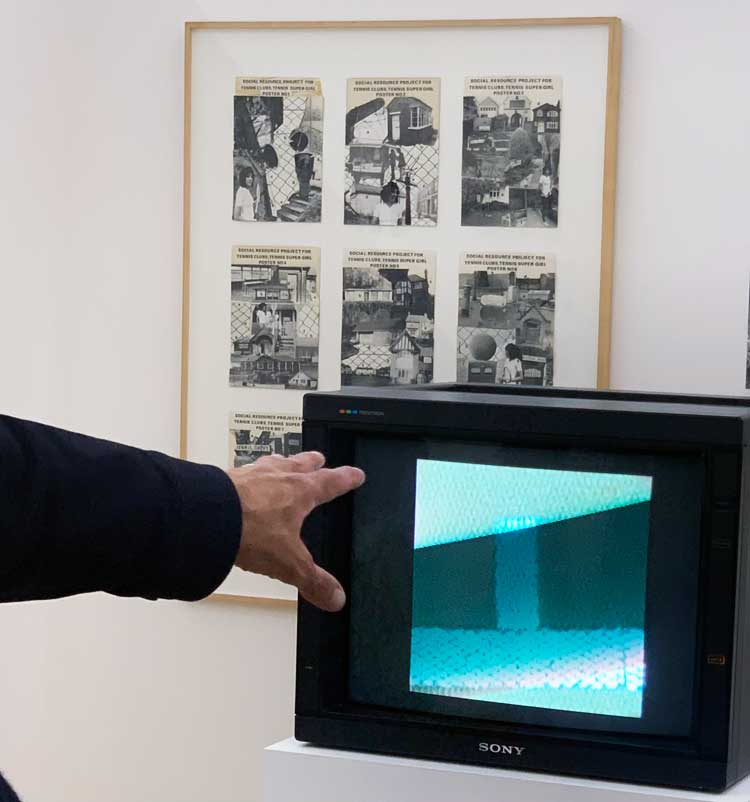
Stephen Willats. Social Resource Project for Tennis Clubs, installation view, Bonington Gallery. Photo: Bronac Ferran.
Again, we might find a contrast with what is being shown around the walls in the outside area of the gallery. Images that relate to the two sites that are now public courts show that one requires pre-payment (like buying a parking ticket) involving calling a telephone number and being given a code to open the locked gates into the court area. Both public tennis court sites were empty of players on the day of Willats’ visit. At one of these, he photographed notices about how to follow the rules of public health while playing tennis at the height of the recent pandemic lockdown, noting that notices have not been removed, or renewed since then.

Stephen Willats. Social Resource Project for Tennis Clubs, installation view, Bonington Gallery. Photo: Bronac Ferran.
The ambient presence of visual signs, and their deterioration or otherwise, takes on an aesthetic importance within the revisiting of the project. Indeed, Willats’ indexical gathering of overlooked data strewn around contrasting tennis club locations in Nottingham this year has produced an unanticipated sense of new social commentary.
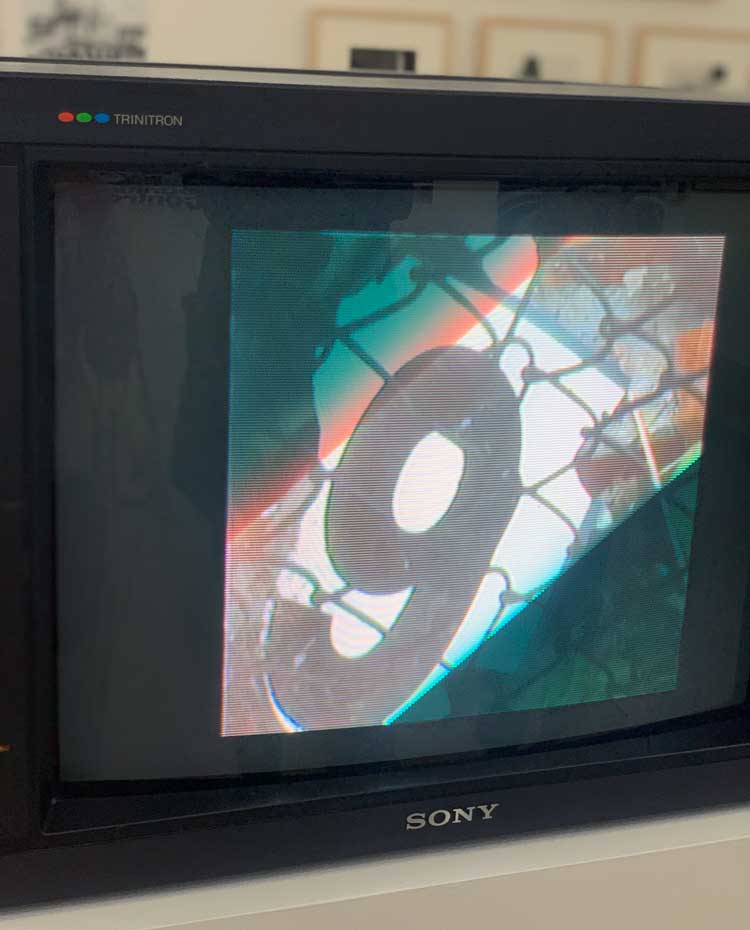
Signs And Messages from The Park Tennis Club Nottingham, 2022. Film. Installation view, Bonington Gallery. Photo: Bronac Ferran.
In the corridor outside the gallery, some unique works from Willats’ personal collection that have recently been acquired by the Nottingham Trent University collection are on display. One is a screenprint entitled Cognition Manifesto, made in 1969 by Willats in the art school print department, located in the same building as the gallery. This sets out the entire theoretical framework that he subsequently progressed in the early 70s. We also see a wall-wide display of blown-up reproductions of all the covers of Willats’ Control magazine since its inception, along with a vitrine showing related material from original Control magazines. Visitors to the exhibition may also acquire a small-press publication, with a new text by Willats, designed in his preferred font, reflecting on the context in which the 1972 project was developed, along with reproductions of the nine Super Girl posters and other print outputs.
I came away with a sense of having experienced an immaculately designed exhibition that highlights the significance of place within the work of this pioneering artist, who turns 80 next year. The approach taken to the display of this material has achieved a degree of renewal that loops aspects of the past into the present and vice versa. In so doing, the exhibition situates Willats as an artist who still has his eyes on cues and signs at the edges of our vision that grow more legible over time as signals of wider and longer-term social transformations.
Reference
1. Stephen Willats. In: Social Resource Project for Tennis Clubs, Stephen Willats, 2022, Bonington Gallery; published by Nottingham Trent University.
2. From worksheet for Visual Homeostatic Information Mesh in Willats’ personal collection.